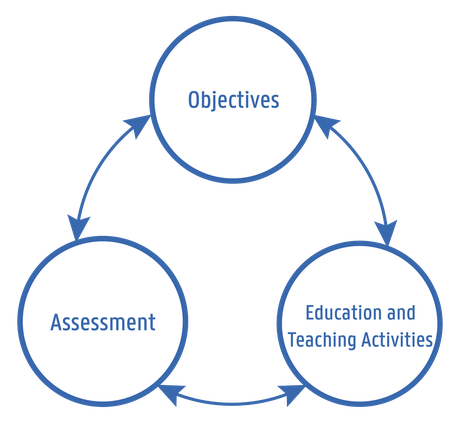What Is Constructive Alignment and Why Is It So Important?
What is Constructive Alignment?
Constructive alignment means bringing into alignment the predetermined competencies, the learning and teaching activities, and the assessment types. It is one of the most influential principles in higher education.
When designing a programme or course unit, you should consider the following three questions:
- What should students know or master after the programme or the course unit? In other words, which objectives (learning outcomes or course competencies) do you aim to reach with these students?
- Which teaching and learning activities are required to teach the students these competencies?
- How to assess whether or not students truly master the intended competencies?
A high-quality learning process properly aligns these three elements (objectives, teaching and learning activities, and assessment methods); they are then “constructively aligned”.

To develop a “constructively aligned” course unit, you should start from the intended competencies, after which you should select the most appropriate education and teaching activities, and assessment methods for these specific competencies. These competencies always comprise a verb that refers to what students have to master, for example:
- apply theory X to Y
- express the importance of concept 2
This verb frequently refers to the relevant learning method the students can apply to acquire the competency, and to those teaching activities lecturers can organize to stimulate students to adopt these learning methods.
Why is Constructive Alignment so Important?
Assessment strongly influences how students learn, which is why it is important that it is properly aligned with education and teaching activities. Only then can you achieve an effective learning process.
This is not the case when the assessment measures other competencies than the ones that were developed during teaching activities, for example:
- Does a certain course unit aim at students being able to run a marathon? Then your teaching activities had better not consist of formal lectures comprising an overview of various running disciplines. Neither is an exam with multiple choice questions about Olympic marathon winners appropriate. Surely the students will then focus on cramming marathon winners rather than on training for a marathon. The course unit then defeats its purpose.
Want to Know More?
Consult the secondary literature upon which this Education Tip is based:
- Biggs, J.B. (1996) Enhancing Teaching through Constructive Alignment, Higher Education, 32, 1–18.
- Biggs, J.B. (1999, 2011). Teaching for Quality Learning at University. Buckingham: Open University Press.
Last modified Feb. 14, 2024, 9:22 a.m.